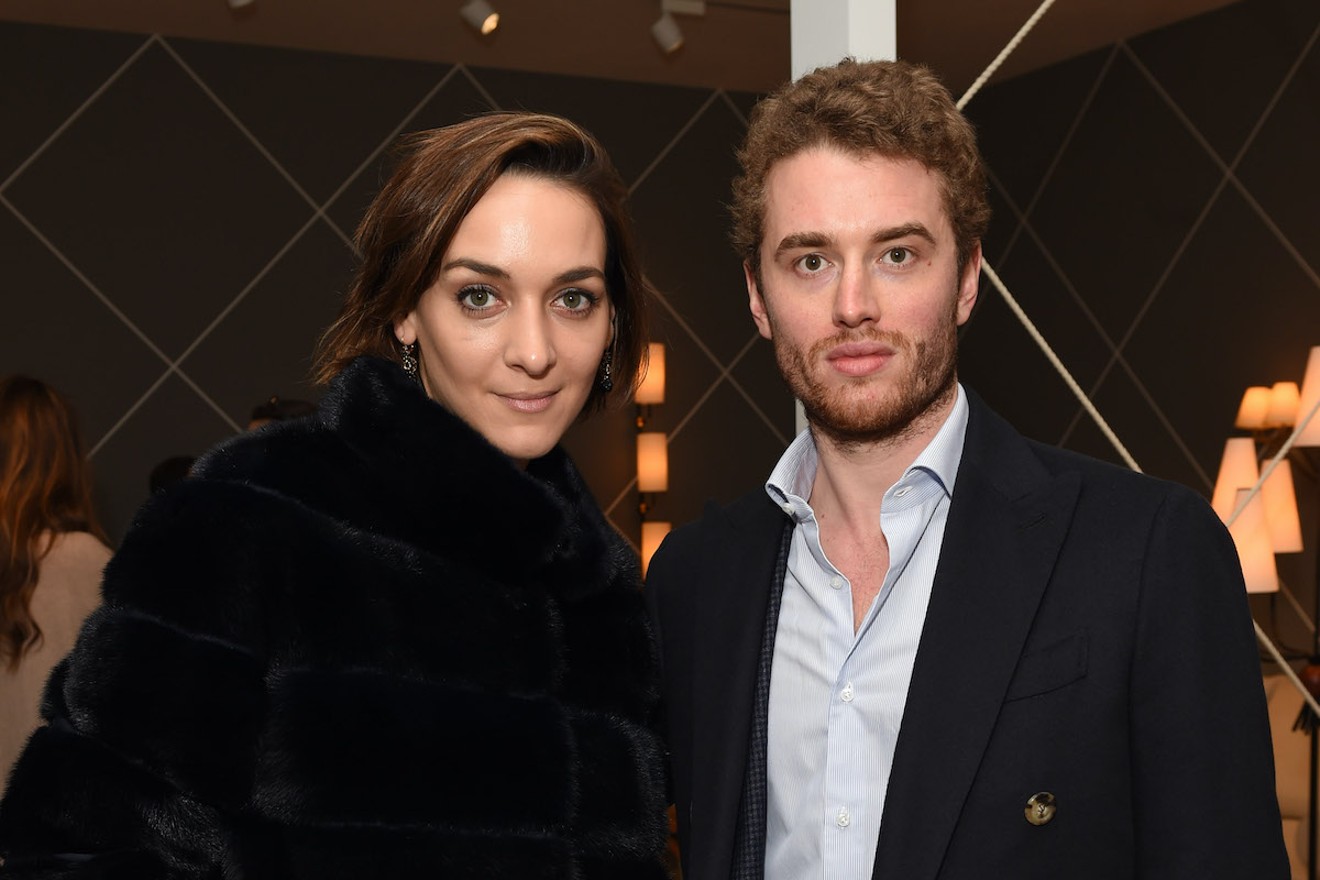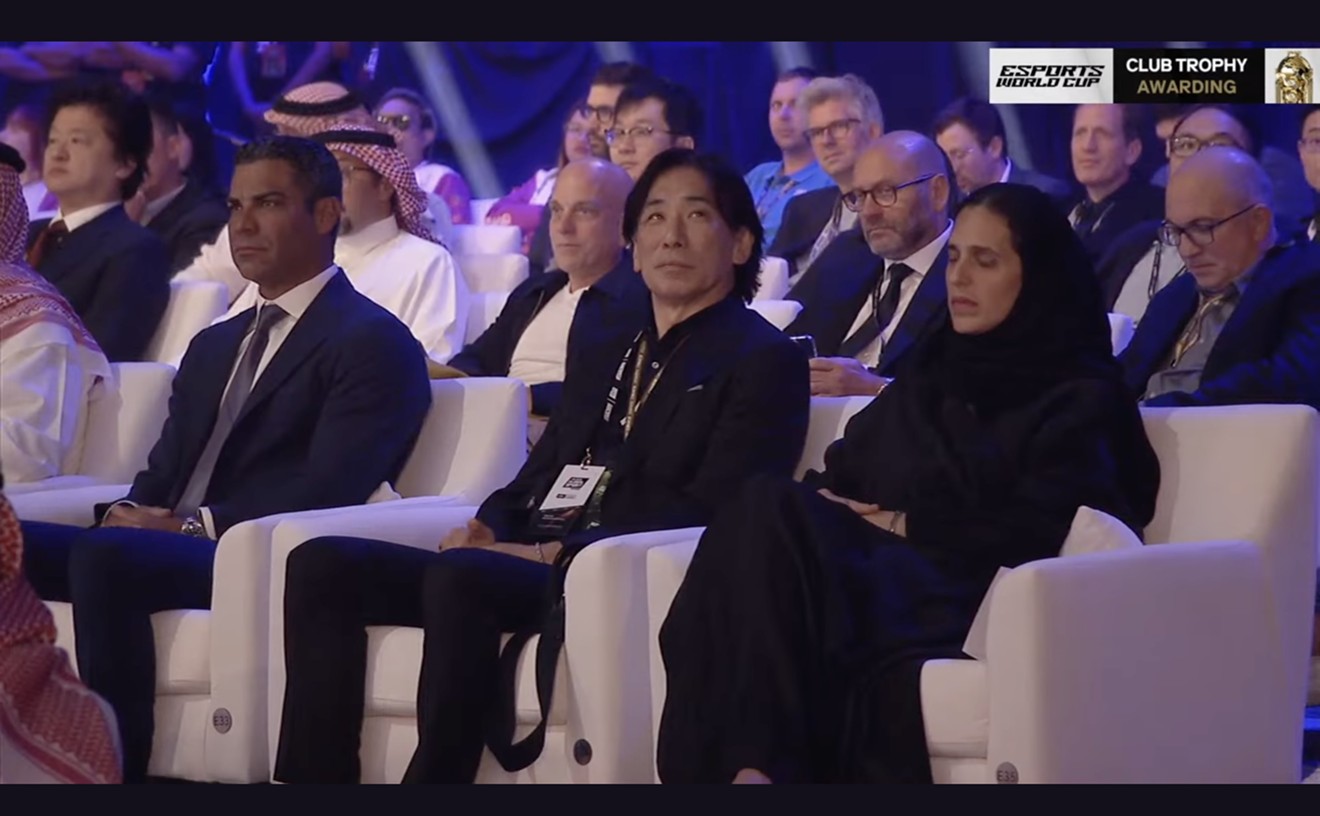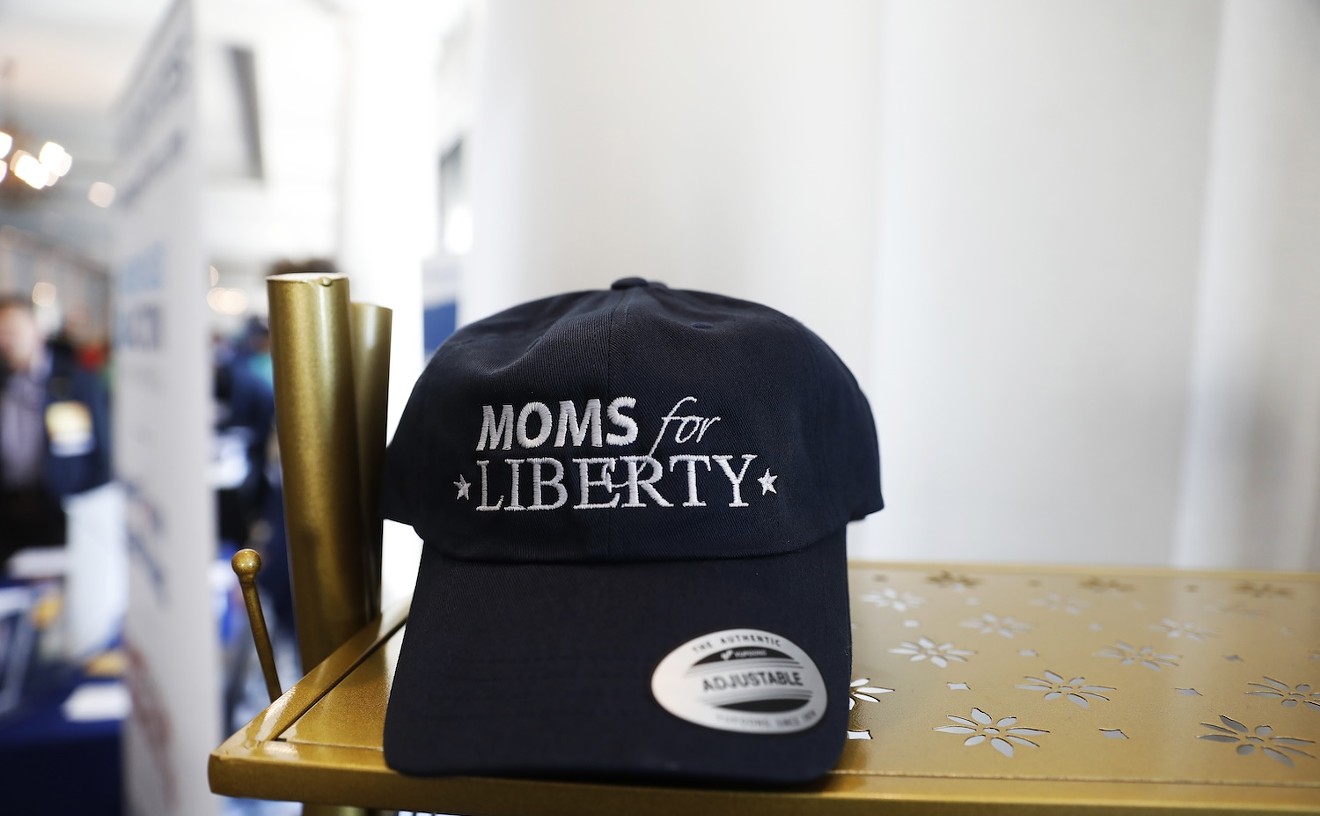A young woman dressed in black opens the glass front door of an art installation in the Miami Design District. She ushers in a couple and leads them to a small room whose sole illumination comes from innumerable glowing acrylic pumpkins arrayed across the floor. Yellow with black polka dots, the gourds are equipped with LED bulbs that cause them to glow from within and reflect off the mirrors that line the walls and the ceiling, giving the sense of a hallucinogenic trip through a multidimensional pumpkin patch.
Since early October, aficionados of Yayoi Kusama — a 90-year-old Japanese artist who has captivated the global contemporary art market through her flamboyant, abstract creations — have forked over $15 a head to wander through her pumpkin "infinity mirror" room, an installation on loan to the Institute of Contemporary Art Miami. On a recent Sunday, showings for the installation, which is located in a nondescript storefront offsite, sold out by midmorning. Tens of thousands more visitors are expected to traverse the psychedelic art space before the end of January, when the installation closes.
Yet All the Eternal Love I Have for Pumpkins is more than a trippy exploration of Kusama's psyche. It's a portal into a handful of multimillion-dollar art-world lawsuits whose trails lead back to one man: Inigo Philbrick, the dashing young gallerist who orchestrated the pumpkin exhibition. Those ensnared by the plot include the Saudi Kingdom, four firms that invest in six-figure works, the auction house Christie's, and Miami's leading contemporary art museum.
It's a sordid saga that lays bare the cutthroat, high-stakes business of art dealing, and it's unfolding just in time for Art Basel Miami Beach, the largest contemporary art fair in North America, which has arrived in town this week for its 17th-annual edition.
Philbrick, the son of a prominent Philadelphia museum director, is fingered as the villain in multiple lawsuits playing out in New York City, London, and Miami.
“It is one of the most brazen art frauds we have seen in recent times.”
tweet this
Aggrieved parties from around the globe accuse him of chicanery and deceit. Philbrick allegedly bilked an investor by jacking up the $12.5 million price for a Jean-Michel Basquiat painting by nearly $6 million. He is said to have sold a 2012 portrait of Pablo Picasso by the Italian painter Rudolf Stingel to three buyers, all of whom are now laying claim to the work — which Philbrick sold yet again this past May at a Christie's auction, where the winning bid topped $6.5 million.
In a suit filed in Miami-Dade Circuit Court, a husband-and-wife team of German art investors asserts ownership of Kusama's pumpkin room, the thrice-sold Stingel, and seven other works. The plaintiffs, accusing Philbrick of breach of contract, believe four of the pieces, valued at $14.1 million, are in storage in Miami and demand their return. Further muddying the waters: news that a Saudi prince who's looking to add to a growing collection that includes a $450 million painting by Leonardo da Vinci recently purchased the pumpkin room.
Philbrick, meanwhile, has ghosted.
According to recent news reports, he failed to appear at two court hearings in London, prompting a judge to freeze his global assets. Bloomberg reports his London gallery is vacant and shuttered. His Miami lawyers recently filed a motion to withdraw as his counsel because he allegedly "failed substantially to fulfill [his] obligations to the attorneys" and because they have not heard from him.
A visit to his gallery in the Miami Design District, located next door to the pumpkin installation, turns up bare walls. The only items visible from the outside are a couple of swivel desk chairs and a lone crate near the entrance. A printed notice on a sheet of paper taped to the front door reads, "The gallery is closed for a show change. We will reopen soon with a solo presentation of: Jana Euler. Please visit us then!" The two phone numbers listed on the notice match numbers listed under Philbrick's name. Both are disconnected.
This past November 22, Philbrick's landlord, Design District Development Partners LLC, sued in circuit court to evict him from the suite and retake possession of the space that houses Kusama's pumpkin room. The gallerist leased the spaces in October 2018 and May 2019, respectively. According to a letter attached to the eviction lawsuit, Philbrick missed his $30,472 rent payment for November.
Philbrick did not respond to multiple emails requesting comment for this story.
Judd Grossman, a Manhattan-based art litigation attorney who represents one of the firms suing Philbrick, believes the gallerist has pulled off one of the greatest art-world cons he can remember.
"It is one of the most brazen art frauds we have seen in recent times," Grossman tells New Times. "He proposed various opportunities and transactions that defrauded many people, including my client."

Daniel Tümpel is a former investment banker; his father was a Rembrandt scholar, his mother a museum director. Tümpel's wife, Loretta Würtenberger, studied copyright and patent law and served as a judge in Berlin's district court. The couple owns two Berlin-based firms: Fine Art Partners (FAP), an investment company that also provides financing to galleries, dealers, and working artists; and the Institute for Artists' Estates, which offers management and consulting services. "Fine Art Partners operates in the background and with the highest level of discretion and confidentiality," its website promises.
Reached by phone, Tümpel said neither he nor Würtenberger would agree to an interview about FAP's dispute with Inigo Philbrick.
According to a lawsuit filed in Miami-Dade Circuit Court in September, FAP's dealings with Philbrick date back to November 2015, when the company contracted with him to purchase, market, and resell three works of art on its behalf: two untitled paintings by Donald Judd and Stingel's portrait of Picasso for a combined $10.8 million. A year later, Philbrick bought the Kusama pumpkins on FAP's behalf for $3.3 million. In late 2017, Tümpel and Würtenberger again contracted with the gallerist to purchase five additional artworks for a total of $13.5 million.
The contracts, which were attached to the lawsuit as exhibits, detail the peculiar math that accompanies big-ticket art investments. For the most part, FAP was required to furnish only 70 percent of the purchase price. The balance was to be withheld until Philbrick resold the work for a "target price" that was also specified in the contract.
Stingel's piece, however, was an exception. Rather than pony up 70 percent of the portrait's $7.1 million price for the work — a 95-by-76-inch canvas by the Italian photorealist that depicts a middle-aged Pablo Picasso in black-and-white. FAP was obligated to put up only half that amount. The contract was clear about the fate of the 65 percent balance due: "Deferred," it read. "Will become due after re-sale of the above work." If all went as planned and the work sold for its target price, FAP and Philbrick would split the profit down the middle.
The other buy-and-resell agreements were a bit more intricate: Once Philbrick flipped a work of art, FAP would get 10 percent of the net profit off the top. Of the remainder, Philbrick would receive 60 percent, and FAP the rest. (For instance, if FAP bought a paining worth $1 million and Philbrick resold it for $1.5 million, he would collect $432,000 and the Germans would recoup their original $700,000 investment with a $368,000 cherry on top.)
“I have a very strong belief that our painting could completely reset the Stingel market...”
tweet this
Once he entered into contracts with FAP, Philbrick had a fiduciary obligation to act in the best interests of Tümpel and Würtenberger, says Thomas Foley, a professor of art law and ethics at the Fashion Institute of Technology in New York. "The dealer must forgo any personal advantage and respect the confidential nature of that agreement," explains Foley, who also serves as an administrative law judge. "Some of those duties would be to deal fairly and honestly with the consignor, provide an accounting as to the dispositions of the artwork, and, of course, avoid conflicts of interest."
Printouts of email correspondence between FAP and Philbrick included in the Miami court file indicate that by early 2019, the business relationship had begun to fracture. On February 24, Tümpel responded to Philbrick's email of the previous day and expressed annoyance that a Russian buyer he identified as "Leonid" was late paying for a painting they had sold to him.
There was also the matter of the Stingel.
"I have been advancing a conversation over the last week or so with Christie's regarding our Stingel Picasso painting," Philbrick had written in his February 23 email. "They, and increasingly I, feel there is an opportunity in May to set a new world auction record for the artist with the painting..."
Philbrick suggested "pricing the work very attractively to sell," with an auction estimate of $5 million to $7 million, "as the way to optimize the final selling price."
He reiterated, "I have a very strong belief that our painting could completely reset the Stingel market..."
Tümpel didn't seem hot on the idea.
"With regard to the Picasso," he wrote, "we would only agree to consign it to Christies [sic] if we would get a guarantee well above our purchase price to reflect the long holding period. I think a selling price should be at least 12 mln USD."
He closed his note by addressing Philbrick's overtures regarding three paintings the gallerist proposed buying on FAP's behalf: a "very filmic" Ed Ruscha whose nautical subject matter would likely "work well in Miami/Palm Beach, where so many of the big collectors incorporate water views into the staging of their art and homes; a "major" Bridget Riley; and a "stunning" Dana Schutz.
"[W]e would want to wait until Leonids [sic] payments arrive before purchasing further works," Tümpel curtly responded.
On March 22, Philbrick wrote once more. He acknowledged Tümpel and Würtenberger were "frustrated" by Leonid's failure to pay and by the lack of movement on the sales front elsewhere. "We've done some amazing deals," he reminded them, and sidestepped their apparent discomfort that he was making new purchases on his own while their funds were still tied up in inventory that wasn't selling.
He also had an update on the Stingel.
"We have confirmed a deal with Christie's at 9m USD, with 50/50 on the overage," he wrote. "I've consigned many major works to auctions both on behalf of clients and from my own inventory, I've never seen so much excitement. Let's now hope that the timing of the sale and the marketing are enough to take us the distance we want it to."
He closed with: "Hope you both have a great weekend, and that we can move on well together. All best, Inigo."
On May 15, the auctioneer's hammer dropped on the Stingel. The winning bid was $6,517,500 — far below the $9 million target. After Christie's took its cut, there would be only $5.7 million to show for a painting FAP and Philbrick had ostensibly purchased for $7.1 million.
Two days later, according to FAP's complaint, "FAP phoned Philbrick to ask why Christies [sic] had published the sales price of US$6,517,500 and not the guaranteed sum of US$9,000,000. Philbrick explained that the work would now be on Christie's books and that there would be internal reasons for Christies [sic] to show a lower number than the guarantee."
Two weeks later, the complaint states, FAP asked Philbrick to send a copy of the $9 million seller's agreement.
Philbrick complied and forwarded a PDF of an eight-page contract "purportedly drafted by Christie's and purportedly signed by both Christie's and Philbrick providing for a guaranteed amount of US$9,000,000." Three months later, according to the complaint, Philbrick assured FAP that Christie's had paid the full $9 million and that FAP would get its money as soon as the gallerist settled up with their co-investor, who was owed $7.2 million for his share.
A September 4 email from Tümpel to Christie's indicates he suspected he had been bilked.
"Since we cannot exclude that Inigo is acting in a criminal manner we would like to ask you further not to share any information with Inigo Philbrick which we exchange with you and your colleagues," Tümpel wrote. "Any warning to him that we are about to discover the truth may result that we could suffer further material damages."
“We believe that is a falsified document.”
tweet this
On September 12, FAP's German attorney, Jan Timmann, sent Christie's the PDF of the $9 million seller's agreement. In a brief email, to which the file was attached, Timmann noted the contract was missing the section that identifies the artwork to which it relates. "[B]ut the sum of 9 m guarantee is exactly what Inigo Philbrick told us was agreed upon the auction... and the [contract's] date of March 25 also fits... So, from first sight it looks as if this sellers [sic] agreement could likely be related to the Stingel (Picasso)."
That evening, the general counsel for Christie's, Jason Pollack, responded.
"We believe that is a falsified document," Pollack wrote. "First, we have no record of that version of the agreement in our files. Second, Inigo Philbrick was not the consignor of that lot."
Not only that, Pollack informed FAP, but also "the buyer is late in paying. The payment was due on Aug. 13th."
On the grounds that the agreements between FAP and Philbrick stipulated the German company would retain sole ownership of the works of art, Tümpel set out to repossess them. He emailed Philbrick repeatedly to demand the gallerist surrender all of FAP's purchases to independent storage facilities.
"I was actually writing to you when your email came in," Philbrick responded September 11. "I'm hugely disappointed that our relationship, after so many successful deals, has deteriorated in this way. This is especially true as I know that we are fundamentally aligned on wanting to maximize our remaining inventory and finish [this chapter of] our partnership with a profitable accounting."
He went on to update Tümpel about his purported progress on the sales front: one work by the painter/sculptor Donald Judd, two paintings by Christopher Wool, and Kusama's pumpkin room — whose showing by the Institute of Contemporary Art Miami (ICA), he hoped, would attract deep-pocketed potential buyers.
"The presentation is being coordinated with a national PR campaign, which should bring us into contact with a number of potential buyers should the ICA fail to raise the funds" to purchase the work itself, Philbrick wrote. "I am still confident they will manage this, but am already in the process of talking to other potential buyers... To further this cause I have donated a meaningful amount of money to underwrite PR, advertising and promotion. The display is going to be a sensation in this city, and a major stopping-off point during Art Basel and the Super Bowl," a reference to the leadup to Super Bowl LIV, which will take place Feburary 2, 2020, in Miami.

His tone sounding increasingly desperate, Philbrick offered FAP a "counter proposal" that would have him release some of the artworks but hold on to the others — "a compromise which allows us to proceed to sales, rather than an impasse."
But by that time, Philbrick must have known the rift with FAP was beyond repair.
A page on the ICA's website regarding the Kusama installation notes, "This special presentation is made possible with support from Inigo Philbrick Gallery." But the museum's site also states the work is on loan from the Collection of the Royal Commission for Al-Ula in Saudi Arabia.
The ICA declined to comment for this story. In a previous statement provided to Bloomberg and Artnet News, museum deputy director Tommy Pace said, "The work is on loan to the museum from a private collection. We were not aware of the dispute when the exhibition was planned, but it appears to be an issue between the previous owners."
In the wake of FAP's lawsuit, two other art investment firms have emerged from the shadows to lay claim to Stingel's Picasso portrait.
“Any con requires some level of trust.”
tweet this
Art collection company Guzzini Properties filed a legal claim to the work in the Supreme Court of New York. The company states it paid $6 million for the painting and two other unnamed works in June 2017. Guzzini asserts that it was the consignor for the Christie's auction and that FAP never consummated its purchase of the Stingel work because it never paid the full price. Wendy Lindstrom, a lawyer for Guzzini, declined to comment.
Satfinance Investment claims it entered into a deal with Philbrick for a 50 percent stake in the Stingel work for $3.35 million. (Guzzini claims Satfinance never paid the money.) The firm is suing the gallerist in London High Court in connection with an agreement to buy a 2012 Basquiat painting, Humidity, for $18.4 million. Satfinance maintains that it paid Philbrick $12.2 million toward the purchase and that Philbrick actually paid only $12.5 million for it — meaning he allegedly pocketed nearly $6 million in the tainted transaction. Adding in the alleged triple dealing with the Stingel and the other works to whose ownership FAP has laid claim, Philbrick might have defrauded his clients to the tune of $40 million.
On November 7, a British court, after being lobbied by FAP, ruled Philbrick cannot move any of his $13.7 million in assets from England and Wales, including works by Judd, Wool, and Kusama.
In an emailed statement, a Christie's spokesperson said the auction house is retaining possession of the Stingel until its ownership is resolved.
"Since Christie's initially discovered the fraudulent use of our brand and falsification of our paperwork, the consignor of the painting has commenced litigation to validate their ownership of the painting," the statement reads. "While Christie's is not a party to any filings, we will continue to hold the artwork while ownership of the painting is determined through the judicial system or otherwise."
In nearly all of the disputes, the individual buyers who claim to have purchased works through Philbrick have not come forward publicly and are not identified. FAP appears to be an exception, though the agreements between the company and the art dealer specify he was to operate as "an undisclosed agent."
"Any con requires some level of trust," says attorney Judd Grossman, who represents Satfinance in the dispute. "Through his professional reputation and his successful sales results, Philbrick built a level of confidence and trust in many of his victims, including Satfinance."
Thomas Foley, who teaches art law at the Fashion Institute of Technology, notes that the art market is largely unregulated and that gallerists need not apply for any special license to set up shop. "That is one of the major problems here. There is no requirement that art dealers — like attorneys and brokers — receive proper training on ethics," Foley tells New Times.
"Unfortunately, you get gallery owners that could be having money troubles, possibly going into bankruptcy," he says. "The risk is they have valuable artwork on their walls. When they are having financial difficulties, it is very tempting to sell a painting for millions of dollars and not tell the owner and play games."
Now 32 years old, Inigo Philbrick has a background in contemporary art that stretches back to his childhood. His father, Harry Philbrick, was director of the Aldrich Contemporary Art Museum in Ridgefield, Connecticut, from 1996 to 2010 and director of the Pennsylvania Academy of the Fine Arts from 2011 to 2016. Three years ago, he founded Philadelphia Contemporary, a private museum where he serves as CEO.
In an emailed statement, the elder Philbrick said he and his son have been estranged for nearly a decade. "I love him and want the best for him," he writes. "The recent allegations I've read in the press are deeply concerning. I have no knowledge of what transpired beyond what has been publicly reported, and hope the situation is resolved soon."
Artnet News has reported that Inigo Philbrick began his career running secondary-market sales for the London-based contemporary art gallery White Cube. In 2011, he began working for Modern Collections, a private secondary market dealership in London run by one of White Cube's owners. Two years later, Philbrick opened a gallery under his own name in London's affluent Mayfair district.
“The recent allegations I’ve read in the press are deeply concerning,” Philbrick’s estranged father says.
tweet this
Handsome, with wavy auburn hair and a patchy beard, Philbrick has appeared regularly in art-society photos in New York City and Miami as he gained traction as a contemporary art expert whose opinions matter.
In 2018, the year Philbrick opened his gallery in the Design District, he served as a panelist at the Art Business Conference in London alongside industry heavyweights Millicent Wilner, a director for the world-renowned gallery Gagosian; Valeria Napoleone, an Italian art collector; and Ralph Taylor, global head of postwar and contemporary art at the international auction house Bonhams.
Two years earlier, in 2016, Marion Maneker, founding editor of the industry bible Art Market Monitor, interviewed Philbrick for a podcast about surging interest among collectors for Rudolf Stingel's work and the business of art dealing.
"I am always amazed by the phobia that people might have that you would try to cut them out of a deal or steal their client," Philbrick told Maneker. "For me, the ideal thing that you have is trust with the person you are talking to, and you two have this great relationship."
He proceeded to relate a story about the time he bought a painting by Carroll Dunham, the father of millennial Hollywood wunderkind Lena Dunham. A client, Philbrick explained, had engaged him to purchase the artwork on his behalf. "He had asked me to bid for him up to $250,000 or $300,000," Philbrick said. "We got to his number and someone outbid me. So I kept bidding on my account instead of his account. And I bought the painting for roughly half a million."
The point, Philbrick said, was that he had risked a gamble his client wasn't willing to make and that he had done so to stimulate the market for Carroll Dunham's work.
"At some point, values have to change or no one is motivated to sell," he told Maneker. "You always need someone to motivate a market a bit."













